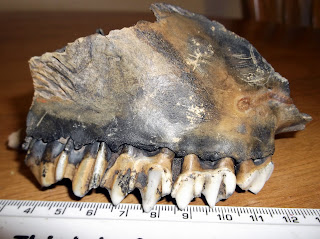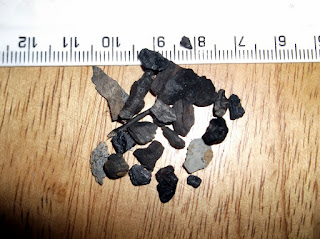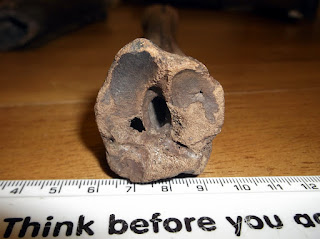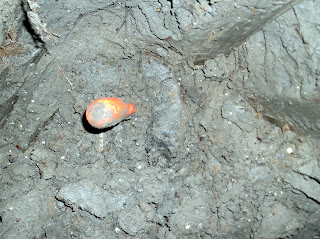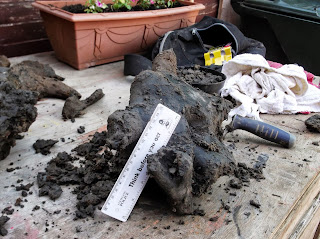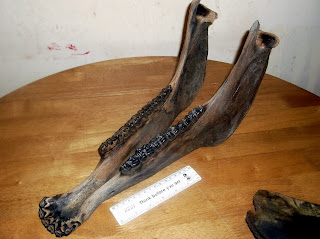This basic record represents over 10 years of excavation and study carried out by myself at a location in Cleveland North East England.
I believe the area to be a prehistoric sacrificial site, that has close connections with the outcrop of the Cleveland Basaltic Andesite Dyke it surrounds.
I have excavated and discovered many well preserved mammal bones including Human in a very small area, situated around an outcrop of the dyke. None of the pieces show signs of butchery or disease. I have also excavated pottery pieces some with food remains still attached. Many of the skulls I have found have what look to be cavities and breaks caused by pieces of the basalt found close by.
In ten years of excavating these deposits I have never discovered any iron or alloy or traces of it.
I have also discovered a shoe after a partial collapse of one of my digs, that could well be part of the same deposits, all of the items listed below have been reported to Tees Archaeology and The Dorman Museum Middlesbrough without response. The Human bone has been examined and removed from my possession via Cleveland Police to Teesside University.
I believe the area to be a prehistoric sacrificial site, that has close connections with the outcrop of the Cleveland Basaltic Andesite Dyke it surrounds.
I have excavated and discovered many well preserved mammal bones including Human in a very small area, situated around an outcrop of the dyke. None of the pieces show signs of butchery or disease. I have also excavated pottery pieces some with food remains still attached. Many of the skulls I have found have what look to be cavities and breaks caused by pieces of the basalt found close by.
In ten years of excavating these deposits I have never discovered any iron or alloy or traces of it.
I have also discovered a shoe after a partial collapse of one of my digs, that could well be part of the same deposits, all of the items listed below have been reported to Tees Archaeology and The Dorman Museum Middlesbrough without response. The Human bone has been examined and removed from my possession via Cleveland Police to Teesside University.
I now believe the site could have been used for thousands of years, all relating to its proximity to the outcrop of the Cleveland Dyke and it meeting with the water.
Below just some of the pieces excavated at the site, although I can not be certain the shoe sole came from the deposits, more information regarding the shoe sole find can be seen below.
Above a Human Tibia shaft outlined in red with a deer mandible is outlined in yellow to the right.
Above and below two Human Femurs found in the same area in the beck, almost certainly from the same deposits ive been excavating, the Femur above was said to be unusually long and robust in a report by Durham University.
Above Shoe sole.
Below a very large Bos scapular, I believe this scapular belonged to an Auroch, as prehistoric domesticated breeds probably never reached this size.
Cervus Mandible
This site was reported to Tees Archaeology, Durham university and Cleveland police, the police finished their investigation regarding the human bones deeming them as ancient, Tees archaeology and Durham university decided it was not very important. I found that very strange, considering the reaction of such a deposit would be if found on a beck bank in London or Durham.
Below just some of the pieces excavated at the site, although I can not be certain the shoe sole came from the deposits, more information regarding the shoe sole find can be seen below.
Below Human Cranium - parietal piece.
Below the antler excavation.
Below the top shaft of the Antler can be seen before excavation, poor images due to problems with my camera at the time.
Below dyke stone found immediately above animal bones.
Below pottery pieces excavated some with food remains, and a rim.
The pot appears to have a high quartz content.
Below human and animal bone found in the beck and excavated, the first image shows 2 Deer mandibles and a Human Tibia shaft half excavated outlined in yellow to the left.
Above a Human Tibia shaft outlined in red with a deer mandible is outlined in yellow to the right.
Above and below two Human Femurs found in the same area in the beck, almost certainly from the same deposits ive been excavating, the Femur above was said to be unusually long and robust in a report by Durham University.
Above the Human Tibia shaft to the left of the Mandibles more bone was excavated including, Bos - Dog or Wolf - Goat - Horse
One Excavation into the beck bank.
Part of the shoe sole found after a collapse of one excavation it was covered in the same clay, and could be from the deposits excavated although I can not be sure.
Below the heel area of the shoe sole.
Below assemblage from one excavation including cervical vertebrae, Deer mandible - Sus leg bone.
Below Goat cranium excavation
Below Goat Mandibles - jaw almost excavated with a large piece of Basaltic Andesite to the bottom right, I found it common to find large pieces like this close to many bone finds.
Below the full assemblage of Goat bone excavated.
Below Bos radius
Below the assemblage from one excavation.
Below full image of the shoe sole found after a collapse of one excavation, as stated the shoe sole was covered in the same deposits as bone excavated, but I can not be certain it came from the same deposits.
Below Cervus mandible and partial maxilla.
Below Unknown Horn core and cranium piece
Below the Human Tibia shaft cleaned and dried.
Below Cervus Mandible and partial Maxilla show earlier, And the Human Tibia shaft.
Below Human Tibia shaft before being fully excavated.
Below the area of the excavation.
Below the Human Tibia and Deer mandible.
Below preserved snails from the deposits.
Below preserved wood - nut shells - stalks - bark.
Below preserved Seeds from the deposits
Below what I am informed are preserved frog bones.
Below assemblage from another excavation including Horse coffin bone Bos metatarsal Atlas vertebrae probably horse, Horse cranium, and Bos horn core cranium piece.
Below Cervus Metatarsal
Below another excavation.
Assemblage including Horse metatarsal - Bos tibia - Goat mandibles - Horn core - Ribs - Vertebrae
Below this image shows another partially excavated bone and a clam shell, I have found many of these in the deposits.
Below partial horse mandible.
Below two of three separate horse mandibles excavated along side a huge red deer antler and other bones in a 4 meter square area, as with all examples found and excavated there was no signs of Butchery.
Below an assemblage shown before being cleaned.
Below the assemblage after cleaning.
Below Wild boar skull.
Below another assemblage including Bos skull - Large Deer mandibles - Maxilla - Large Dog or Wolf mandible.
Below Large dog or wolf mandible, and unusual teeth possibly deer.
Cervus Mandible
Below unfused and dislocated leg bone.
Below Horse skull - goat or sheep mandibles - small horn core
Below another excavation
Below the assemblage including Scapula leg bones Vertebrae - Rib - Pelvis section.
Below another Horse mandible
Below as mentioned earlier this is the third Mandible found along side a huge red deer antler, along with other bone in less than a 4 square metre excavated area.
Below Horse scapular
Below Horse incisors'
Below more partially excavated bone.
Below dog Skull
This is the fully excavated Cervus Elephus - Red deer Antler, I've not traced a larger piece in Britain or Europe.





































































